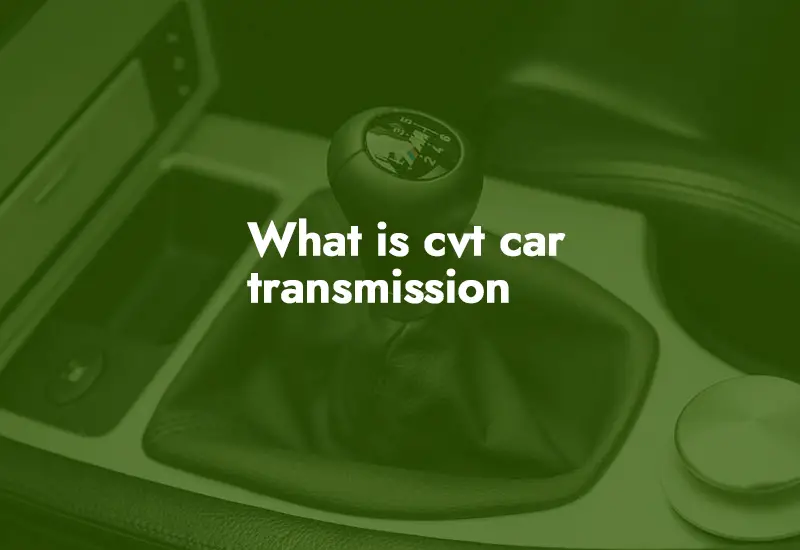As an Amazon Associate, I earn from qualifying purchases at no extra cost to you.
What is CVT Car Transmission? Demystifying the Revolutionary Powerhouse
Imagine driving a car that feels incredibly smooth as you accelerate, with no noticeable shifts between gears. The ride feels seamless, almost like you’re floating. This is the magic of a Continuous Variable Transmission (CVT). If you've ever wondered what it is or why it's so different from a regular transmission, you've come to the right place.
CVT has become a common feature in many modern vehicles, offering efficiency, smoothness, and an overall more enjoyable driving experience. In this blog, we'll break down exactly what a CVT transmission is, how it works, its benefits, and the pros and cons compared to traditional transmissions. By the end, you'll understand why CVT is becoming a popular choice for both drivers and automakers alike.

What is CVT Transmission?
A CVT, or Continuous Variable Transmission, is an automatic transmission system that provides a smooth and seamless driving experience by offering an infinite range of gear ratios. Unlike traditional automatic or manual transmissions that have a set number of gears, a CVT adjusts seamlessly to keep the engine operating at the optimal power range. This means the engine doesn't have to work as hard during acceleration, which can improve both fuel efficiency and overall driving comfort.
Traditional Transmissions vs. CVT
To better understand CVT, let's first look at traditional transmissions. Traditional automatic transmissions typically use a series of gears—usually anywhere from 4 to 10—that shift in a predictable pattern. When you accelerate, the transmission moves from one gear to the next, each gear having a different ratio. These gear shifts are often noticeable, and the engine speed (revolutions per minute or RPM) fluctuates with each shift. It's a system that works well but can feel somewhat rough and inefficient at times, especially when trying to achieve optimal fuel economy.
On the other hand, a CVT doesn't use gears at all. Instead, it uses two pulleys connected by a flexible belt or chain. These pulleys are designed to continuously change their size, which allows for a nearly infinite number of gear ratios. The result is a smooth and uninterrupted flow of power from the engine to the wheels, without the distinct shifts found in traditional automatic transmissions.
How Does a CVT Work?
Now that we know the basic difference between traditional transmissions and CVT, let's dive deeper into how a CVT works. At the heart of this system are two pulleys and a belt or chain that connects them. These pulleys are adjustable, meaning their diameters can change depending on the car's speed and driving conditions.
- Primary Pulley: This is the larger pulley that connects to the engine's output shaft. Its size changes depending on how much power is needed for acceleration. When you need more power, the pulley grows in size.
- Secondary Pulley: The secondary pulley is connected to the drive shaft that turns the wheels. As the primary pulley changes size, so does the secondary pulley, ensuring the proper power transfer.
- Belt or Chain: The belt or chain connects the two pulleys and adjusts in tension as the pulleys change in size. The belt/chain allows the system to maintain continuous power delivery without the need for traditional gear shifts.
As the vehicle accelerates or decelerates, the system automatically adjusts the size of the pulleys to find the perfect gear ratio. The result is that the engine operates within its optimal power band, leading to smoother acceleration and better fuel efficiency.
Types of CVTs
There are several types of CVTs available, and each operates in slightly different ways. The most common types of CVTs are:
- Belt-Driven CVT: This is the most traditional and widely used type of CVT. It uses a belt (usually made of steel or rubber) to connect the two pulleys. The belt moves between the pulleys, adjusting their sizes to provide continuous power transfer.
- Chain-Driven CVT: Instead of a belt, some CVTs use a chain to connect the pulleys. A chain-driven CVT can be more durable and offer higher torque capacity than belt-driven systems, but they are less common in passenger cars.
- Hydrostatic CVT: Used mostly in heavy machinery or specialized vehicles like lawnmowers, hydrostatic CVTs rely on hydraulic fluid to transmit power between pulleys. While not typically found in passenger cars, hydrostatic CVTs are known for their reliability in demanding applications.
- Electronic CVT: This version of the CVT incorporates electronic controls to optimize the system's performance. The use of sensors and computer technology can help ensure smoother shifts and better fuel efficiency under varying driving conditions.
Benefits of CVT Transmission
There are several advantages to driving a car equipped with a CVT transmission. Some of the most notable benefits include:
1. Improved Fuel Efficiency
One of the main selling points of a CVT is its ability to improve fuel efficiency. Because the transmission constantly adjusts to keep the engine at its most efficient RPM range, it can reduce fuel consumption. Traditional automatic transmissions often waste energy by having the engine run at higher RPMs than necessary. In contrast, a CVT ensures that the engine operates at its optimal power band, leading to better mileage.
2. Smooth and Seamless Driving Experience
Another major benefit of a CVT is the smoothness it offers. Traditional automatic transmissions can have noticeable shifts as they change gears. This can sometimes result in a jarring or uncomfortable ride, especially when accelerating quickly. With a CVT, there are no fixed gears, which means no shifting between them. The car accelerates smoothly, without any abrupt changes in engine speed or power delivery.
3. Better Acceleration
CVTs are known for providing faster and smoother acceleration. In traditional automatic transmissions, each gear has a specific ratio, which means the car needs to shift through them as it accelerates. This shifting process can sometimes cause delays or interruptions in acceleration. With a CVT, the engine continuously adjusts to the ideal power range, allowing for smoother and quicker acceleration without any lag.
4. Less Maintenance
Although the maintenance needs of a CVT can vary depending on the make and model, they generally require less maintenance than traditional automatic transmissions. There are fewer moving parts involved, and no need for the complex gear shifting mechanisms used in traditional systems. However, regular maintenance such as fluid changes is still important to keep the CVT running smoothly.
Drawbacks of CVT Transmission
While there are plenty of advantages to a CVT, it's not without its drawbacks. Let's take a look at some of the potential downsides.
1. Lack of Driving Engagement
One of the most commonly cited drawbacks of a CVT is the lack of driving engagement. For some drivers, the sensation of a traditional transmission shifting through gears provides a sense of control and excitement. CVTs, by contrast, provide a smooth but often less involving driving experience, which can be a downside for those who enjoy the feel of shifting gears.
2. Engine Noise
Because a CVT maintains the engine at an optimal RPM range, it can sometimes cause the engine to rev higher than it would in a traditional transmission. This can lead to more engine noise, especially during rapid acceleration. While the car's performance may be smoother, the engine noise may be more pronounced, which some drivers find unpleasant.
3. Limited Towing Capacity
CVTs are generally not suited for heavy-duty towing. While they work well for daily driving and light loads, they are not as robust as traditional automatic transmissions when it comes to towing large trailers or heavy equipment. If towing capacity is a priority, a traditional automatic transmission may be a better option.
4. Possible Durability Issues
While CVTs are designed to last, they are still a relatively new technology compared to traditional automatic transmissions. Some drivers have reported long-term durability issues with CVTs, especially in high-mileage vehicles. While these issues are not widespread, it's still something to keep in mind when considering a CVT-equipped vehicle.
Is a CVT Right for You?
So, is a CVT the right choice for you? The answer depends on your driving habits and priorities. If you're someone who values smooth, fuel-efficient driving and doesn't mind the lack of gear shifts, a CVT could be an excellent option. However, if you enjoy a more traditional driving experience or need a transmission that can handle heavy loads, you might want to consider a car with a traditional automatic transmission.
At the end of the day, both CVT and traditional transmissions have their merits, and the right choice will depend on what you're looking for in your vehicle. For many drivers, the benefits of a CVT—particularly in terms of fuel economy and smoothness—make it a great option, but it's essential to weigh all factors before making your decision.
Are These Questions in Your Mind?
Is it true that CVTs are more fuel-efficient than traditional transmissions?
Yes, CVTs can be more fuel-efficient because they allow the engine to operate at the optimal RPM range, reducing unnecessary fuel consumption.
Can CVT transmissions be repaired, or do they need to be replaced?
CVT transmissions can be repaired, but the repair process can be more complicated and expensive than traditional transmissions. Regular maintenance can help prolong the life of a CVT.
Do I need to worry about CVT fluid?
Yes, just like traditional transmissions, CVTs require fluid changes to keep the system running smoothly. It's important to check the manufacturer's recommendations for maintenance intervals.
Can a CVT handle high-performance driving?
CVTs are generally not designed for high-performance driving. They excel in providing smooth and efficient power delivery, but they may not offer the quick and precise shifts needed for sporty driving. However, some high-performance vehicles do use advanced CVTs with paddle shifters to simulate gear changes.
Do I need to drive differently with a CVT?
No, you don't need to drive differently with a CVT. The driving experience is similar to that of a traditional automatic transmission. Simply put the car in drive and go. The CVT will automatically adjust to provide the best performance and efficiency.
Is it true that CVTs are less reliable than traditional transmissions?
The reliability of a CVT can vary depending on the make and model of the vehicle. Some drivers have reported issues, but overall, modern CVTs are designed to be reliable. Regular maintenance and proper care are crucial for longevity.
Can a CVT be used in all types of vehicles?
CVTs are most commonly found in smaller cars and crossovers. They are less common in larger vehicles and trucks, mainly due to their limited towing capacity and durability concerns under heavy loads.
Do I lose control with a CVT?
Not necessarily. While you may not feel the traditional gear shifts, modern CVTs often come with manual mode options, allowing drivers to simulate gear changes using paddle shifters or a gear lever. This feature can provide a more engaging driving experience if desired.
Is it more expensive to maintain a CVT?
Maintenance costs for CVTs can be higher than traditional automatic transmissions due to their complexity and specialized components. However, the overall cost difference may be offset by the improved fuel efficiency and smoother driving experience offered by CVTs.
Do I need special driving skills to operate a car with a CVT?
No special skills are required to drive a car with a CVT. The operation is similar to that of a traditional automatic transmission. The main difference you'll notice is the lack of gear shifts, which can make for a smoother and quieter ride.
I hope this comprehensive guide has shed light on what CVT car transmission is and how it can enhance your driving experience. From its seamless acceleration to its fuel efficiency, the CVT offers a modern solution to traditional transmission systems. While it may not be perfect for every driver, understanding its benefits and drawbacks can help you make an informed decision when considering your next vehicle. Whether you prioritize a smooth ride, better fuel economy, or simply want to experience the latest in automotive technology, a CVT-equipped car might just be the right choice for you.











